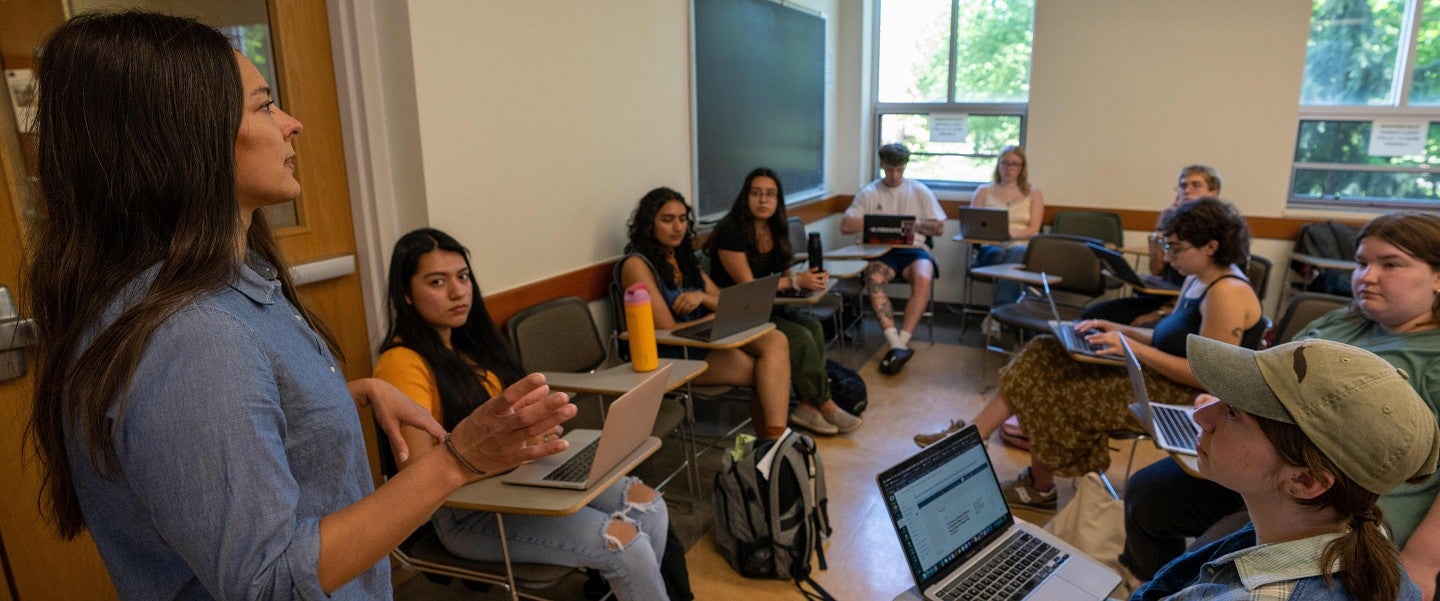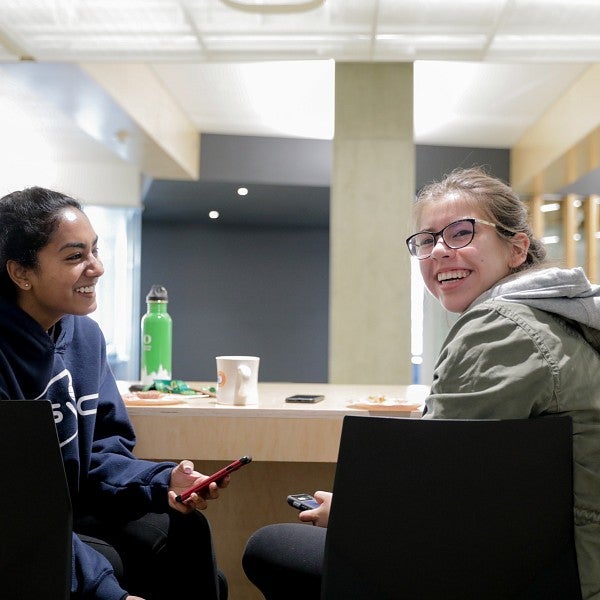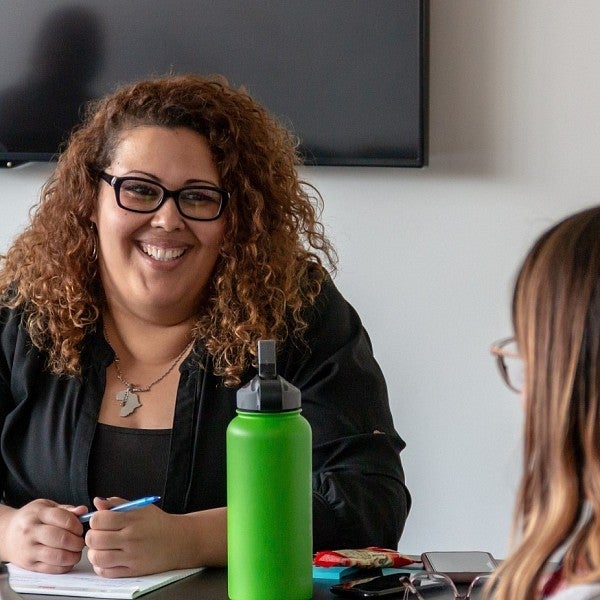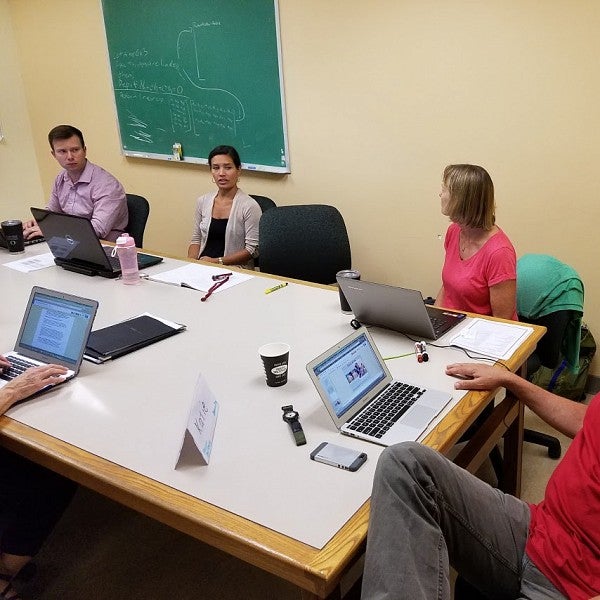
Professional, Inclusive, Engaged, and Research-Informed Teaching
A resource to support Teaching Excellence at UO
What is Teaching Excellence at UO?
The University of Oregon is committed to exceptional teaching, discovery, and service. Achieving excellence in teaching means first defining it to reflect the best of what we know about how people learn and the rich practices that characterize the work of UO’s distinguished faculty.
The university uses “professional, inclusive, engaged, and research-informed” as principles characterizing teaching excellence. These principles have been adopted into policy as evaluation standards and are reflected in the selection criteria for UO’s teaching awards and fellowships.
This page defines those principles and offers examples of how they inform course design and daily practice. It is meant to be a living document—revised by disciplines to reflect their contexts. While no instructor should feel that adopting every practice on this list is required (or even encouraged), TEP hopes that every instructor might find this a valuable prompt for reflection and teaching development, and that every academic unit might find this a useful resource in the development of clear, distinctive unit-level criteria for evaluation.

Professional Teaching
Professional teaching is:
- Readily available, coherently organized, and high quality course materials; syllabi that establish student workload, learning objectives, grading, and class policy expectations.
- Respectful and timely communication with students. Respectful teaching does not mean that the professor cannot give appropriate critical feedback.
- Students' activities in and out of class designed and organized to maximize student learning.

For example, UO instructors might:
- Include on the syllabus or other materials contact details, information about how to address you, and friendly guidance on why and how to use office hours or otherwise access your support. Respond to students’ requests for information and feedback reliably and promptly (this does not mean instantaneously.)
- Ensure essential course information is easy to find and organized with an eye toward straightforward navigation.
- Offer written and verbal guidance on how to engage with the course—how individual activities and assignments are linked to learning objectives, strategies for reading course texts, guidance on especially high workload weeks, etc.
- Maintain course materials and student information on Canvas (the university-approved and FERPA compliant learning management system).
- Adopt free or low-cost open educational resources.
- Take steps to make course materials more accessible like captioning videos, adding alt-text to images, and checking that documents can be read by screen readers.
- Use students’ time in and out of class strategically and actively by, for example:
- assigning preparatory work beyond reading-only assignments to get more out of students’ class time;
- encouraging students to make connections between the preparatory work and the following class or online activities;
- using students’ class time to harness the power and energy of the peer community to share ideas, demonstrations, real-time experiences, new scenarios, problems, artifacts, and complications that capture students’ knowledge and skills;
- Provide students with after-class opportunities for reinforcement and reflection.
- Participate in departmental efforts to assess student learning of key goals and revise class activities based on the results.
Inclusive Teaching
Inclusive teaching is:
- Instruction designed to ensure every student can participate fully and that their presence and participation is valued.
- The content of the course reflects the diversity of the field's practitioners, the contested and evolving status of knowledge, the value of academic questions beyond the academy and of lived experience as evidence, and/or other efforts to help students see themselves in the work of the course.

For example, UO instructors might:
- Convey that each student brings valuable assets and goals to their work. [4]
- Introduce the instructor’s own intellectual journey and process of expert thought. [5]
- Use course materials that represent the racial, ethnic, gender, ability, intellectual, and socioeconomic diversity of the field and the contested and evolving status of knowledge. [6] [7] [8]
- Deploy a range of methods to engage students and bring out their strengths. [9]
- Address students by their chosen names and pronouns; this includes finding ways to use names in large-classes and online fora. [10]
- Know students’ goals for their learning and find ways to connect the concerns of the course to students’ own concerns. [11] [12]
- Maximize student motivation by leveraging students’ sense of the relevance, rigor, and supportiveness of a course—and of their own self efficacy within it. [13]
- Build classroom community, including through establishing clear expectations around classroom engagement. [14]
- Design courses with physical and content accessibility in mind. [15] [16]

Engaged Teaching
Engaged teachers have a "demonstrated reflective teaching practice, including through the regular revision of courses in content and pedagogy."

For example, UO instructors might:
- Reflect on their teaching practice and make changes over time that are informed by experimentation, professional teaching development, collegial interactions and class observations, student feedback, and the scholarship of teaching and learning.
- Solicit and reflect on student feedback, and consider what changes, if any, should be made in the course.
- Attend workshops, conferences, or institutes about teaching and learning; read books or articles about teaching and learning; participate in teaching journal or book clubs; have formal or informal discussions with their peers about teaching and learning.
- Present at workshops and conferences their insights, innovations, or experiments in teaching and learning.
- Conduct a peer review for a colleague or invite a colleague to conduct a formative peer review of their own class.
- Serve as a teaching mentor for a colleague.
- Know the UO policy and support resources that surround their teaching; know the UO policy and support resources relevant to their students.
- Publish scholarship related to teaching and learning.
- Serve as an active member of the Provost’s Teaching Academy, or as a CAIT (community accelerating the impact of teaching) fellow.
- Invest in curriculum renewal processes.
- Participate in a unit or university committee related to teaching and learning (core education committee, curriculum committee, teaching effectiveness committee, peer review committee, continuous improvement and evaluation of teaching senate committee, etc.)
Research-Informed Teaching
Research-informed teaching means both inviting students into UO’s research mission and drawing on research about how students learn. It includes. It includes:
- Instruction models a process or culture of inquiry characteristic of disciplinary or professional expertise.
- Evaluation of student performance linked to explicit goals for student learning established by faculty member, unit, and, for core education, university; these goals and criteria for meeting them are made clear to students.
- Timely, useful feedback on activities and assignments, including indicating students' progress in course.
- Instruction engages, challenges, and supports students.

For example, to invite students into research approaches, UO instructors might:
- Lead with questions and model expert thought by “thinking aloud” when encountering problems. [5]
- Provide students with course-based research experiences or other projects that engage students directly in the scholarly methods of the discipline.
- Adjust course material to reflect current debates, topics, and trends in the discipline.
- Partner with students to create new knowledge.
For example, to act on research on student learning, UO instructors might:
- Communicate compelling goals for student learning and design courses tightly aligned with those goals (backward design). [17] [18]
- Clearly convey the purpose, process for completion, and criteria for evaluation of class assignments before students begin work (transparency). [19]
- Build occasions for student reflection about their own learning processes, challenges, and growth (metacognition). [6] [20] [21]
- Use students’ time in and out of class strategically and actively by, for example:
- assigning preparatory work beyond reading-only assignments to get more out of students’ class time; [22]
- encouraging students to make connections between the preparatory work and the following class or online activities; [14]
- using students’ class time to harness the power and energy of the peer community to share ideas, demonstrations, real-time experiences, new scenarios, problems, artifacts, and complications that capture students’ knowledge and skills; [23] [24] [25]
- providing students with after-class opportunities for reinforcement and reflection; [20] [26]
- breaking up didactic lectures into smaller 10-15-minute segments with opportunities for active student engagement, processing, questioning and knowledge integration. [14]
- Provide students simple, helpful [27] [28] feedback on low-stakes practice which could include the use of rubrics [14], student peer review [29], instructor “think alouds” [5] or other time saving techniques.
Works Cited
- R. V. Magee, "The Way of ColorInsight: Understanding Race and Law Effectively Through Mindfulness-Based ColorInsight Practices," Georgetown Journal of Law & Modern Critical Race Perspectives, vol. 8, pp. 251-304, 2016.
- K. Gannon, "The Case for Inclusive Teaching," The Chronicle of Higher Education, 27 February 2018.
- T. F. Freeman, L. H. Anderman and J. M. Jensen, "Sense of Belonging in College Freshmen at the Classroom and Campus Levels," The Journal of Experimental Education, vol. 75, no. 3, pp. 203-220, 2007.
- G. D. Kuh, J. Kinzie, J. A. Buckley, b. K. Bridges and J. C. Hayek, "What Matters to Student Success: A Review of the Literature," National Postsecondary Education Cooperative, 2006.
- B. Davey, "Think Aloud- Modeling the Cognitive Processes of Reading Comprehension," Journal of Reading, vol. 27, no. 1, pp. 44-47, 1983.
- S. A. Ambrose, M. W. Bridges, M. DiPietro, M. C. Lovett and M. K. Norman, How Learning Works: Seven Research-Based Principles for Smart Teaching, Hoboken, New Jersey: Jossey-Bass, 2010.
- J. Handelsman, S. Miller and C. Pfund, “Chapter 4: Diversity,” in Scientific Teaching, New York, W. H. Freeman, 2007.
- S. R. Harper and C. H. Davis III, "Eight Actions to Reduce Racism in College Classrooms," Academe, vol. 102, no. 6, pp. 30-34, 2016.
- K. D. Tanner, "Structure Matters: Twenty-One Teaching Strategies to Promote Student Engagement and Cultivate Classroom Equity," CBE-Life Sciences Education, vol. 12, pp. 322-331, 2013.
- K. M. Cooper, B. Haney, A. Krieg and S. E. Brownell, "What’s in a Name? The Importance of Students Perceiving That an Instructor Knows Their Names in a High-Enrollment Biology Classroom," CBE-Life Sciences Education, vol. 16, no. 1, p. ar8, 2017.
- G. Ladson-Billings, "But That's Just Good Teaching! The Case for Culturally Relevant Pedagogy," Theory Into Practice, vol. 34, no. 3, pp. 159-165, 1995.
- M. C. Jackson, G. Galvez, I. Landa, P. Buonora and D. B. Thoman, "Science That Matters: The Importance of a Cultural Connection in Underrepresented Students' Science Pursuit," CBE-Life Sciences Education, vol. 15, no. 3, pp. ar42, 1-12, 2016.
- National Academy of Sciences, Engineering, and Medicine, How People Learn II: Learners, Contexts, and Cultures, Washington, DC: The National Academies Press, 2018.
- L. Nilson, Teaching at Its Best: A Research-Based Resource for College Instructors, 3rd ed., San Francisco: Jossey-Bass, 2010.
- A. Meyer, D. H. Rose and D. Gordon, Universal Design for Learning: Theory and Practice, Wakefield, MA: CAST Professional Publishing, 2014.
- E. Kim and K. C. e. Aquino, Disability as Diversity in Higher Education: Policies and Practices to Enhance Student Success, New York: Routledge, 2017.
- G. Wiggins and J. McTighe, Understanding by Design, 2nd ed., Alexandria, Virginia: Association for Supervision and Curriculum Development, 2005.
- L. D. Fink, Creating Significant Learning Experiences, San Francisco: Jossey-Bass, 2013.
- M.-A. Winkelmes, M. Bernacki, J. Butler, M. Zochowski, J. Golanics and e. al., "A Teaching Intervention that Increases Underserved College Students' Success," Peer Review, vol. 18, no. 1/2, pp. 31-36, 2016.
- P. C. Brown, H. L. Roediger and M. A. McDaniel, Make it Stick: The Science of Successful Learning, Cambridge, Massachusetts: Belknap Press, 2014.
- C. Dirks, M. P. Wenderoth and M. Withers, Assessment In the College Science Classroom, New York: W. H. Freeman, 2014.
- S. Freeman, D. Haak and M. P. Wenderoth, "Increased Course Structure Improves Performance in Introductory Biology," CBE-Life Sciences Education, vol. 10, no. 2, pp. 175-186, 2011.
- J. K. Knight and C. J. Brame, "Peer Instruction," CBE-Life Sciences Education, vol. 17, no. 2, p. fe5, 2018.
- J. K. Knight and C. J. Brame, "Evidence-Based Teaching Guide: Peer Instruction," CBE-Life Sciences Education, 2018. [Online]. Available: http://lse.ascb.org/evidence-based-teaching-guides/peer-instruction/.
- S. Freeman, S. L. Eddy, M. McDonough, M. K. Smith, N. Okoroafor, H. Jordt and M. P. Wenderoth, “Active learning increases student performance in science, engineering, and mathematics,” Proceedings of the National Academy of Sciences, vol. 111, no. 23, p. 8410–8415, 2015.
- P. Connor-Greene, "Making Connections: Evaluating the Effectiveness of Journal Writing in Enhancing Student Learning," Teaching of Psychology, vol. 27, no. 1, pp. 44-46, 2000.
- D. J. Nicol and D. Macfarlane-Dick, "Formative Assessment and Self-Regulated Learning: A Model and Seven Principles of Good Feedback Practice," Studies in Higher Education, vol. 31, no. 2, pp. 199-218, 2006.
- D. S. Yeager, V. Purdie-Vaughns, J. Garcia and e. al., "Breaking the Cycle of Mistrust: Wise Interventions to Provide Critical Feedback Across the Racial Divide," Journal of Educational Psychology: General, vol. 143, no. 2, pp. 804-824, 2014.
- D. Nicol, A. Thompson and C. Breslin, "Rethinking feedback practices in higher education: a peer review," Assessment and Evaluation in Higher Education, vol. 39, no. 1, pp. 102-122, 2014.
- C. Crouch and E. Mazur, "Peer- Instruction: Ten Years of Experience and Results," American Journal of Physics, vol. 69, pp. 970-977, 2001.
